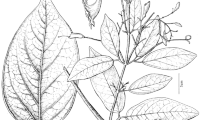Abstract
Three new species of Melastomataceae (Blakeeae) are described:Blakea subpanduriformis, Topobea adscendens, andT. bullata. All are climbers endemic to the montane forests of the eastern slopes of the Andes in southern Ecuador. In this region, 35% of the Ecuadorian species and 41% of the endemic Ecuadorian species of Melastomataceae occur. The discovery of these three new endemic species underlines the diversity of Melastomataceae occurring on the slopes of the Andes in southeastern Ecuador.
Resumen
Se describen tres especies nuevas de Melastomataceae (Blakeeae):Blakea subpanduriformis, Topobea adscendens, yT. bullata. Todas son trepadoras endémicas de los bosques de montaña en las laderas orientales de los Andes en el sur de Ecuador. En esta región crece el 35% de las especies ecuatorianas de Melastomataceae y el 41% de las especies de esta familia que son endémicas de Ecuador. El descubrimiento de estas tres nuevas especies resalta la diversidad de Melastomataceae en las laderas sur-orientales de los Andes ecuatorianos.
Similar content being viewed by others
Literature Cited
Almeda, F. 1990. New species and new combinations inBlakea andTopobea (Melastomataceae), with an historical perspective on generic limits in the Tribe Blakeeae. Proc. Calif. Acad. Sci. Ser. 4, 46: 299–326.
Barthlott, W., W. Lauer &A. Placke. 1996. Global distribution of species diversity in vascular plants: towards a world map of phytodiversity. Erdkunde 50: 317–327.
Borchsenius, F. 1997. Patterns of plant species endemism in Ecuador. Biodiv. & Conserv. 6: 379–399.
Bussmann, R. W. 2001. The montane forests of Reserva Biológica San Francisco, Zamora-Chinchipe, Ecuador—vegetation, zonation and natural regeneration. Erde 132: 11–24.
Cotton, E. 2000a. Six new species of melastomataceae from Ecuador. Nordic J. Bot. 20: 179–191.
— 2000b. Melastomataceae. Pages 230–250.In: R. Valencia et al., editors. Libro rojo de las plantas endémicas del Ecuador 2000. Herbario OCA. Pontificia Universidad Católiea del Ecuador, Quito.
— 2002. Melastomataceae en el sur de Ecuador. Pages 137–158.In: Z. Aguirre et al., editors. Botánica austroecuatoriana—Estudios sobre los recursos vegetales en las provincias de El Oro, Loja y Zamora-Chinchipe. Ediciones Abya Yala. Quito.
Hagedorn, A. 2001. Extent and significance of soil erosion in southern Ecuadon. Erde 132: 75–92.
Renner, S. S. 1999. Melastomataceae. Pages 561–585.In: P. M. Jørgensen & S. León-Yánez, editors. Catalogue of the vascular plants of Ecuador. Monogr. Syst. Bot. Missouri Bot. Gard. Vol. 75. Missouri Botanical Garden Press, St. Louis.
Schrumpf, M., G. Guggenberger, C. Valarezo &W. Zech. 2001. Tropical montane rain forest soils— development and nutrient status along an altitudinal gradient in the south Ecuadorian Andes. Erde 132: 43–59.
Wurdack, J. J. 1980. Melastomataceae.In: G. Harling & B. Sparre, editors. Flora of Ecuador 13: 1–403.
Author information
Authors and Affiliations
Rights and permissions
About this article
Cite this article
Cotton, E., Matezki, S. Ecuadorian novelties in Blakea and Topobea (Melastomataceae). Brittonia 55, 73–81 (2003). https://doi.org/10.1663/0007-196X(2003)055[0073:ENIBAT]2.0.CO;2
Issue Date:
DOI: https://doi.org/10.1663/0007-196X(2003)055[0073:ENIBAT]2.0.CO;2




